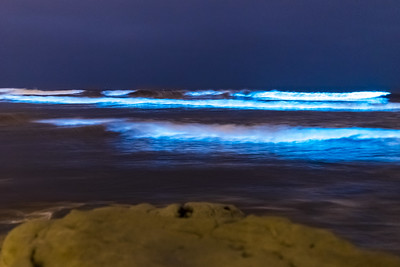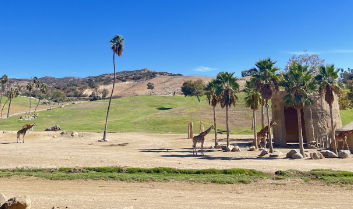Bioluminescent waves have recently appeared across many Southern California beaches. During this time of the year, tiny organisms called Lingulodinium polyedra, also known as phytoplankton, accumulate by the coastline. During the day, they are red, orange and brown, but at night they turn a glowing electric blue. This spectacle of nature captures the attention of many, including UHS students.
“It was really crazy to see because it was much brighter than I thought it would be,” junior Laird DeOlden said.
Bioluminescent waves are the result of a phenomenon known as the red tide or algae bloom. Algae blooms are caused by warm ocean conditions, and it occurs when living organisms emit light through a chemical reaction within their bodies.
“I thought that [it was] really pretty and fascinating,” junior Tulan Alshahrani said. “Although I had to stay up late just to see it, [it was] worth it. They kind of remind me of the mermaid show ‘H2O’.”
Typically, the intensity and frequency of the waves depend on factors such as water temperature, nutrient availability and wave action. These factors affect how bright the phytoplankton will be at night. Bioluminescence is also known as “cold light,” meaning more than 20% of the light generates thermal radiation.
“I was just really amazed because it didn’t seem possible in nature,” DeOlden said.
The phenomenon is not unique to phytoplankton. Many marine creatures depend on bioluminescence for various reasons such as attracting prey, acting as a defense mechanism or deterring potential threats. Overall, bioluminescence in the ocean enhances the dynamic of the many different species in the ecosystem.
“It is a great example of how diverse the ocean is compared to the terrestrial ecosystem,” Mr. David Knight said.
As a teacher of AP Biology and Marine Science, Knight felt that while the waves are not necessarily important for students to know about, they are a unique part of living so close to coastal ecosystems.
“I have never seen them before, but I would like to see them,” Knight said.
Although the beauty of bioluminescent waves tends to attract crowds of visitors, it is very important to enjoy them responsibly and refrain from disturbing the environment. Since phytoplankton play such an important role in the ocean’s ecosystem, conservation initiatives are vital to ensure others also have the opportunity to see and experience this unique part of nature.
To date, there are multiple places where people can go to spot these waves. Beaches such as Newport, Laguna, Oxnard, Malibu and San Diego have all been reported to have bioluminescent waves. Although there is no guarantee that one will spot the bioluminescent waves, the best time to see them is from 9 p.m. to 3 a.m.






![“The amazing science club, unite[s] to experiment new ways to grow their knowledge” Miles Hexun said.](https://uhsswordandshield.com/wp-content/uploads/2024/11/IMG_5875-e1731965934409-1200x723.jpg)



